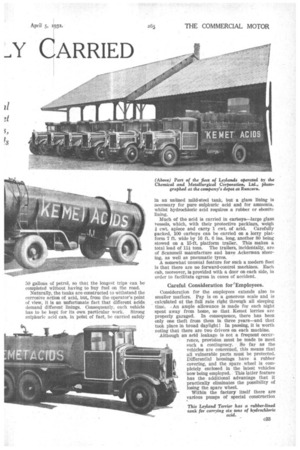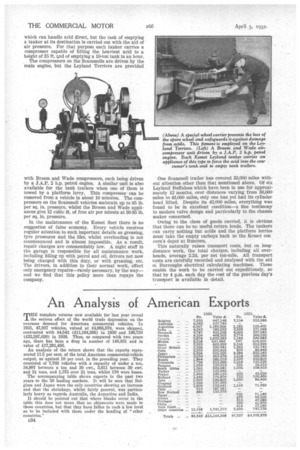DANGEROUS ACIDS SAF ARRIED by road moto
Page 54

Page 55

Page 56

If you've noticed an error in this article please click here to report it so we can fix it.
How the Chemical and Meta& Corporation, Ltd., which Runs a of Leyland and Scammell Vei Carries Dangerous and Corrosive Daily Over Long Distance
LITTLE thought is required to realize that in transporting dangerous and corrosive fluids, unusual precautions are necessary. That these precautions extend beyond the obvious, however, was made clear during a visit to the Astmoor Works of the Chemical and Metallurgical Corporation, Ltd., at Runcorn, Cheshire. This establishment, incidentally, is prominent in the heavy chemical industry, not only on account of its size, but also because it embodies the most modern methods, the factory having quite recently been built on a virgin site.
At present only half the site of 324 acres is occupied, this including 1,000 yds. of frontage to the Manchester Ship Canal. Here, at a private wharf, most of the raw material arrives. There are also railway facilities, including 24 miles of track inside the factory boundaries.
Some idea of the magnitude of the undertaking is conveyed by the fact that it employs 100 rail tank wagons to carry some of its materials and precincts. These include sulphuric acid, hydrochloric acid, various dipping acids, zinc chloride, red lead, litharge, Glauber's salt, ammonia and ammonium sulphate.
Hundreds of Tons a Week.
As to quantities, the Astmoor Works is able weekly to produce 600 tons of 100 per cent, sulphuric acid and in the same time 900 tons of hydrochloric acid. At the other end of the list, the works can turn out each week 80 tons of Glauber's salt and 200 tons of ammonium sulphate.
Some of the products call for no special precautions In transport, but the acids and the ammonia are carried exclusively in the company's own vehicles. By road the daily load averages about 125 net tons, the journeys being of various lengths. The longest regular trip is that to Surrey, others being to Birmingham, Hereford, London and Cardiff.
Because no sale is complete until the goods are delivered, and in order that delivery promises shall be kept, the transport and sales are controlled by the commercial manager, Mr. C. W. Ashton, who believes that it is sound economy to buy the best of everything, including labour.
The road motor fleet under his charge consists entirely of Leyland and Scammell vehicles. There are seven Leyland Buffaloes and a Scammell four-wheeler, all with platform bodies. The tankers include c32 50 gallons of petrol, so that the longest trips can be completed without having to buy fuel on the road.
Naturally, the tanks are constructed to withstand the corrosive action of acid, hut, from the operator's point of view, it is an unfortunate fact that different acids demand different linings. Consequently, each vehicle has to be kept for its own particular work. Strong sulphuric acid can, in point of fact, be carried safely in an unlined mild-steel tank, but a glass lining is necessary for pure sulphuric acid and for ammonia, whilst hydrochloric acid requires a rubber or ebonite lining.
Much of the acid is carried in carboys—large glass vessels, which, with their protective packings, weigh I cwt. apiece and carry 1 cwt. of acid. Carefully packed, 100 carboys can be carried on a lorry platform 7 ft. wide by 16 ft. 6 ins, long, another 80 being stowed on a 15-ft. platform trailer. This makes a total load of 11i tons. The trailers, incidentally, are of Scammell manufacture and have Ackerman steering, as well as pneumatic tyres.
A somewhat unusual feature for such a modern fleet is that there are no forward-control machines. Each cab, moreover, Is provided with a door on each side, in order to facilitate egress in cases of accident
Careful Consideration for lErnployees.
Consideration for the employees extends also to smaller readers. Pay is on a generous scale and is calculated at the full rate right through all sleeping time. . An ample allowance is made for each night spent away from home, so that Kemet lorries are properly garaged. In consequence, there has been only one theft from them in three years—and that took place in broad daylight! In passing, it is worth noting that there are two drivers on each machine.
Although an acid leakage is not a frequent occurrence, provision must be made to meet such a contingency. So far as the vehicles are concerned, this means that all vulnerable parts must be protected.
Differential housings have a rubber covering, and the spare wheel is com pletely enclosed in the latest vehicles now being employed. This latter feature has the additional advantage that it practically eliminates the possibility of losing the spare wheel.
Within the factory itself there are various pumps of special construction which can handle acid direct, but the task of emptying a tanker at its destination is carried out with the aid of air pressure. For that purpose each tanker carries a compressor capable of lifting the heaviest acid to a height of 35 ft. r,,nd of emptying a 10-ton tank in an hour.
The compressors on the Scammells are driven by the main engine, but the Leyland Terriers are provided with Broom and Wade compressors, each being driven by a J.A.P. 2 h.p. petrol engine. A similar unit is also available for the tank trailers when one of them is towed by a platform lorry. This compressor can be removed from a vehicle in about 10 minutes. The compressors on the Scammell vehicles maintain up to 65 lb. per sq. in. pressure, whilst the Broom and Wade appliances give 12 cubic ft. of free air per minute at 30-35 lb. per sq. in. pressure.
In the maintenance of the Kemet fleet there is no suggestion of false economy. Every vehicle receives regular attention to such important details as greasing, tyre pressures and the like, whilst overloading is not countenanced and is almost impossible. As a result, repair charges are commendably low. A night staff in the garage is responsible for all maintenance work, including filling up with petrol and oil, drivers not now being charged with this duty, or with greasing, etc. The drivers, in addition to their normal work, effect only emergency repairs-rarely necessary, by the wayand we find that this policy more than repays the company. One Scammell trailer has covered 32,000 miles without attention other than that mentioned above. Of six Leyland Buffaloes which have been in use for approximately 12 months, over distances varying from 36,000 miles to 43,000 miles, only one has yet had its cylinder head lifted. Despite its 42,000 miles, everything was found to be in excellent condition-a fine testimony to modern valve design and particularly to the chassis maker concerned.
Owing to the class of goods carried, it is obvious that there can be no useful return loads. The tankers can carry nothing but acids and the platform lorries must take the empty carboys back to the Kemet con cern's depot at Runcorn.
This naturally raises transport costs, but on longdistance work, the total charges, including all overheads, average 2.2d. per net ton-mile. All transport costs are carefully recorded and analysed with the aid oi Burroughs electrical calculating machines. These enable the work to be carried out expeditiously, so that by 4 p.m. each day the cost of the previous day's transport is available in detail.












































































































